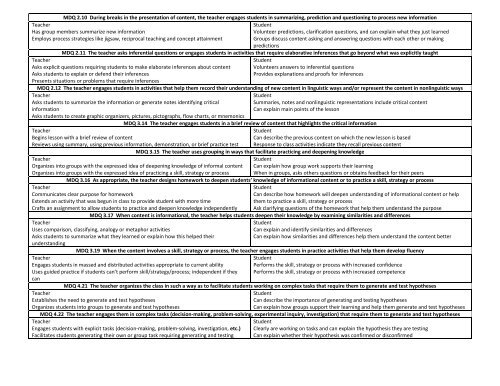eq-ees-teacher-evaluation
eq-ees-teacher-evaluation
eq-ees-teacher-evaluation
Create successful ePaper yourself
Turn your PDF publications into a flip-book with our unique Google optimized e-Paper software.
MDQ 2.10 During breaks in the presentation of content, the <strong>teacher</strong> engages students in summarizing, prediction and questioning to process new information<br />
Teacher<br />
Has group members summarize new information<br />
Employs process strategies like jigsaw, reciprocal teaching and concept attainment<br />
Student<br />
Volunteer predictions, clarification questions, and can explain what they just learned<br />
Groups discuss content asking and answering questions with each other or making<br />
predictions<br />
MDQ 2.11 The <strong>teacher</strong> asks inferential questions or engages students in activities that r<strong>eq</strong>uire elaborative inferences that go beyond what was explicitly taught<br />
Teacher<br />
Asks explicit questions r<strong>eq</strong>uiring students to make elaborate inferences about content<br />
Asks students to explain or defend their inferences<br />
Presents situations or problems that r<strong>eq</strong>uire inferences<br />
Student<br />
Volunteers answers to inferential questions<br />
Provides explanations and proofs for inferences<br />
MDQ 2.12 The <strong>teacher</strong> engages students in activities that help them record their understanding of new content in linguistic ways and/or represent the content in nonlinguistic ways<br />
Teacher<br />
Asks students to summarize the information or generate notes identifying critical<br />
information<br />
Asks students to create graphic organizers, pictures, pictographs, flow charts, or mnemonics<br />
Student<br />
Summaries, notes and nonlinguistic representations include critical content<br />
Can explain main points of the lesson<br />
MDQ 3.14 The <strong>teacher</strong> engages students in a brief review of content that highlights the critical information<br />
Teacher<br />
Begins lesson with a brief review of content<br />
Reviews using summary, using previous information, demonstration, or brief practice test<br />
Student<br />
Can describe the previous content on which the new lesson is based<br />
Response to class activities indicate they recall previous content<br />
MDQ 3.15 The <strong>teacher</strong> uses grouping in ways that facilitate practicing and deepening knowledge<br />
Teacher<br />
Organizes into groups with the expressed idea of deepening knowledge of informal content<br />
Organizes into groups with the expressed idea of practicing a skill, strategy or process<br />
Student<br />
Can explain how group work supports their learning<br />
When in groups, asks others questions or obtains feedback for their peers<br />
MDQ 3.16 As appropriate, the <strong>teacher</strong> designs homework to deepen students’ knowledge of informational content or to practice a skill, strategy or process<br />
Teacher<br />
Communicates clear purpose for homework<br />
Extends an activity that was begun in class to provide student with more time<br />
Crafts an assignment to allow students to practice and deepen knowledge independently<br />
Student<br />
Can describe how homework will deepen understanding of informational content or help<br />
them to practice a skill, strategy or process<br />
Ask clarifying questions of the homework that help them understand the purpose<br />
MDQ 3.17 When content is informational, the <strong>teacher</strong> helps students deepen their knowledge by examining similarities and differences<br />
Teacher<br />
Uses comparison, classifying, analogy or metaphor activities<br />
Asks students to summarize what they learned or explain how this helped their<br />
understanding<br />
Student<br />
Can explain and identify similarities and differences<br />
Can explain how similarities and differences help them understand the content better<br />
MDQ 3.19 When the content involves a skill, strategy or process, the <strong>teacher</strong> engages students in practice activities that help them develop fluency<br />
Teacher<br />
Engages students in massed and distributed activities appropriate to current ability<br />
Uses guided practice if students can’t perform skill/strategy/process; independent if they<br />
can<br />
Student<br />
Performs the skill, strategy or process with increased confidence<br />
Performs the skill, strategy or process with increased competence<br />
MDQ 4.21 The <strong>teacher</strong> organizes the class in such a way as to facilitate students working on complex tasks that r<strong>eq</strong>uire them to generate and test hypotheses<br />
Teacher<br />
Establishes the need to generate and test hypotheses<br />
Organizes students into groups to generate and test hypotheses<br />
Student<br />
Can describe the importance of generating and testing hypotheses<br />
Can explain how groups support their learning and help them generate and test hypotheses<br />
MDQ 4.22 The <strong>teacher</strong> engages them in complex tasks (decision-making, problem-solving, experimental inquiry, investigation) that r<strong>eq</strong>uire them to generate and test hypotheses<br />
Teacher<br />
Engages students with explicit tasks (decision-making, problem-solving, investigation, etc.)<br />
Facilitates students generating their own or group task r<strong>eq</strong>uiring generating and testing<br />
Student<br />
Clearly are working on tasks and can explain the hypothesis they are testing<br />
Can explain whether their hypothesis was confirmed or disconfirmed


